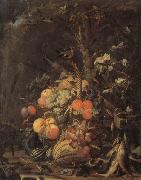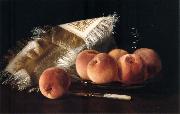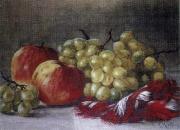
Oil On
Canvas, Real Flavor of Old Masters
|
MIGNON, Abraham
|
|||
|
|
|||
| Dutch Baroque Era Painter, 1640-1679 Dutch painter, was born at Frankfurt. His father, a merchant, placed him under the still-life painter Jacob Marrel, by whom he was taken to the Netherlands about 1660. He then worked under Jan Davidszoon de Heem at Utrecht, where in 1675 he married the daughter of the painter Cornelis Willaerts. Sibylle Merian (1647-1717), daughter of the engraver Matthew Merian, became his pupil and achieved distinction as a flower painter. He died at Utrecht. Mignon devoted himself almost exclusively to flowers, fruit, birds and other still-life, though at times he also attempted portraiture. His flower pieces are marked by careful finish and delicate handling. His favourite scheme was to introduce red or white roses in the centre of the canvas and to set the whole group of flowers against a dark background. Nowhere can his work be seen to better advantage than at the Dresden Gallery, which contains fifteen of his paintings, twelve of which are signed. Six of his pictures are at the Louvre, four at the Hermitage, and other examples are to be found at the museums of Amsterdam, | |||
|
|
|||
|
|
Fruit new3/MIGNON, Abraham-563327.jpg Painting ID:: 28382 Visit European Gallery |
mk60 Oil on canvas 35x27 1/2" | |
Height Width |
INS/CM |
||
|
X |
|
||
|
|
|||
|
Frida Kahlo
|
|||
|
|
|||
| 1907-54 Mexican painter, b. Coyoacen. As a result of an accident at age 15, Kahlo turned her attention from a medical career to painting. Drawing on her personal experiences, her works are often shocking in their stark portrayal of pain and the harsh lives of women. Fifty-five of her 143 paintings are self-portraits incorporating a personal symbolism complete with graphic anatomical references. She was also influenced by indigenous Mexican culture, aspects of which she portrayed in bright colors, with a mixture of realism and symbolism. Her paintings attracted the attention of the artist Diego Rivera, whom she later married. Although Kahlo's work is sometimes classified as surrealist and she did exhibit several times with European surrealists, she herself disputed the label. Her preoccupation with female themes and the figurative candor with which she expressed them made her something of a feminist cult figure in the last decades of the 20th cent. | |||
|
|
|||
| This artist (Frida Kahlo) is not available now. | |||
|
|
|||
|
Hirst, Claude Raguet
|
|||
|
|
|||
| American Painter, 1855-1942 | |||
|
|
|||
|
|
Fruit new12/Hirst, Claude Raguet-945588.jpg Painting ID:: 39123 Visit European Gallery |
mk143 c.1885-88 Oil on canvas 9x14in | |
Height Width |
INS/CM |
||
|
X |
|
||
|
|
|||
|
Hirst, Claude Raguet
|
|||
|
|
|||
| American Painter, 1855-1942 | |||
|
|
|||
|
|
Fruit new12/Hirst, Claude Raguet-897652.jpg Painting ID:: 39160 Visit European Gallery |
mk143 1886 Watercolor on paper 8x12in | |
Height Width |
INS/CM |
||
|
X |
|
||
|
|
|||









